Task Arithmetic in the Tangent Space: Improved Editing of Pre-Trained Models
Task arithmetic has recently emerged as a cost-effective and scalable approach to edit pre-trained models directly in weight space: By adding the fine-tuned weights of different tasks, the model's performance can be improved on these tasks, while negating them leads to task forgetting. Yet, our understanding of the effectiveness of task arithmetic and its underlying principles remains limited. We present a comprehensive study of task arithmetic in vision-language models and show that weight disentanglement is the crucial factor that makes it effective. This property arises during pre-training and manifests when distinct directions in weight space govern separate, localized regions in function space associated with the tasks. Notably, we show that fine-tuning models in their tangent space by linearizing them amplifies weight disentanglement. This leads to substantial performance improvements across multiple task arithmetic benchmarks and diverse models. Building on these findings, we provide theoretical and empirical analyses of the neural tangent kernel (NTK) of these models and establish a compelling link between task arithmetic and the spatial localization of the NTK eigenfunctions. Overall, our work uncovers novel insights into the fundamental mechanisms of task arithmetic and offers a more reliable and effective approach to edit pre-trained models through the NTK linearization.
Problem:: Task Arithmetic의 작동 메커니즘에 대한 불명확한 이해
Solution:: Task Arithmetic의 핵심 메커니즘으로 Weight Disentanglement 개념 제시/Tangent Space에서 직접 파인튜닝하는 새로운 접근법 개발
Novelty:: Task Arithmetic이 선형성이 아닌 Weight Disentanglement에 의해 작동함을 규명/사전 학습 과정에서 Eigenfunction 국소화가 자연스럽게 발생함을 발견
Note:: 사전 학습은 의미적으로 관련된 특성들을 구조화하는 과정
Summary
- Task Arithmetic의 핵심 특성 → 각 태스크가 서로 교차하지 않는 영역에서만 작용
- 초기 가설 → 작은 변화 영역에서 Neural Tangent Kernel(NTK)을 사용한 predictor처럼 선형적 동작 예상
- 사전 학습(pretrain)은 가중치 크게 변화 → 비선형적
- 파인튜닝은 선형적일 것으로 예상
- 초기 가설 → 작은 변화 영역에서 Neural Tangent Kernel(NTK)을 사용한 predictor처럼 선형적 동작 예상
- 실험 결과 → 파인튜닝도 비선형적으로 작동
- 기존 선형성 가설로는 설명 불가 → Task Arithmetic 작동 메커니즘 재탐색 필요
- 발견된 핵심 메커니즘 → Weight Disentanglement
- Weight Disentanglement의 의미 → 가중치 공간에서 각 태스크 방향이 서로 다른 입력 공간의 국소화된 영역을 독립적으로 제어
- 추가 발견 → 이러한 특성은 사전 학습 과정에서 자연스럽게 발현 됨
- 중요한 검증 → 무작위 초기화 모델에서는 해당 특성 미발견
Motivation
- Pre-Trained Model은 현대 머신러닝 시스템에서 핵심적인 역할 수행
- 다운스트림 태스크 성능 향상, 사람 선호도 반영, 견고성 증가를 위한 모델 편집 필요성 증가
- 기존 모델 편집 방법은 비용이 많이 드는 Joint Fine-Tuning과 인간 피드백에 의존해 확장성 제한
Task Arithmetic과 핵심 특성
- Task Arithmetic과 Weight Interpolation이 비용 효율적이고 확장 가능한 모델 편집 방법으로 등장
- Task Vector
: 파인튜닝된 가중치와 사전 학습된 가중치의 차이 ( ) - 서로 다른 태스크에 대한 Task Vector를 더하거나 빼서 모델 성능 조작 가능
- Task Vector
- Task Arithmetic은 각 태스크가 서로 교차하지 않는 영역에서만 작용해야 효과적으로 동작
- 이런 특성은 Property 1(Task Arithmetic)으로 공식화
- 한 태스크 벡터를 더하는 것이 다른 태스크 영역의 모델 출력을 수정하지 않아야 함
기존 가설: Linear Regime
- Task Arithmetic이 작동하는 이유에 대한 기존 가설
- 기존 가설: 사전 학습된 모델이 파인튜닝 시 선형 레짐(linear regime)에서 작동
- Neural Tangent Kernel(NTK)에 의해 동작이 결정된다고 추측
- 이론적으로 너비가 무한한 신경망에서는 NTK가 일정하게 유지되며 비선형성이 선형화됨
- 선형 레짐에서는 가중치 공간의 연산이 함수 공간에서 유사하게 유지됨 →
일 때, 가 유지됨
- 사전 학습(pretrain)은 큰 파라미터 변화로 이루어지므로 비선형 레짐에서 작동
- 파인튜닝은 상대적으로 작은 변화로 이루어지므로 선형 레짐에서 작동할 것으로 예상
- 그러나 실험 결과 CLIP 모델은 파인튜닝 시에도 비선형 레짐에서 작동함을 발견
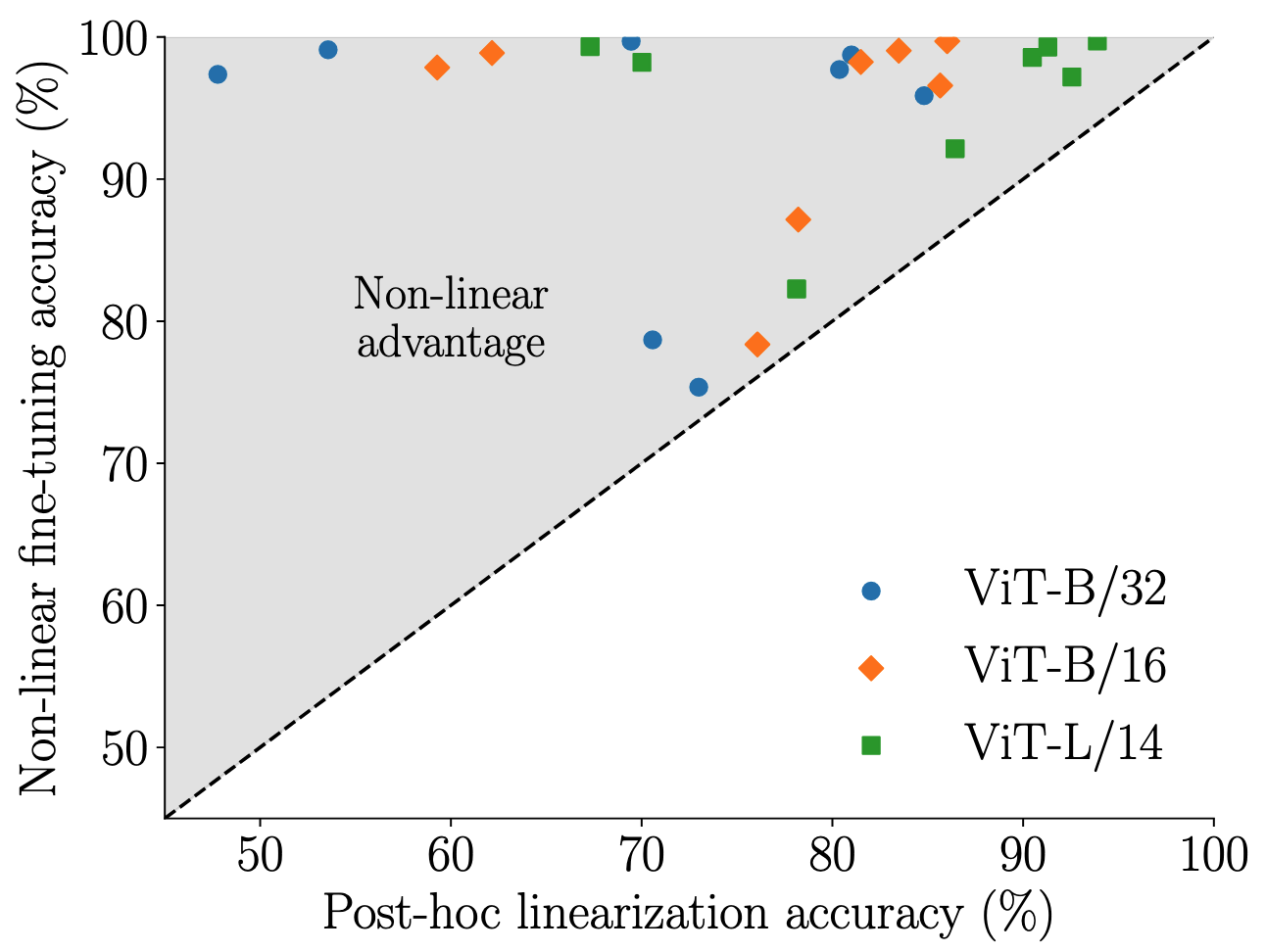
- NTK가 정상적으로 작동 한다면 (선형 레짐에서 동작 한다면) 비선형 파인 튜닝과 사후 선형화 모델 간 성능 차이가 없어야 함
- 비선형적으로 파인튜닝된 모델과 사후 선형화 모델 간 큰 성능 차이 존재 → Linear Regime 때문이면 Non-linear advantage가 없어야 함
- 이는 단순한 선형성만으로 Task Arithmetic을 설명할 수 없음을 시사
Neural Tangent Kernel (NTK)
- Neural Tangent Kernel은 가중치 공간과 함수 공간 사이의 선형 관계를 정의하는 핵심 개념
- 초기화 가중치
주변에서 신경망은 1차 테일러 전개로 근사 가능:
- 이 근사는 커널 머신의 예측과 동등해짐: 두 입력
와 사이의 NTK는 다음과 같이 정의:
- 선형화된 모델을 훈련한 후 새로운 입력
에 대한 예측은 다음과 같이 표현 가능:
- 여기서
는 각 훈련 샘플의 가중치, 는 훈련 데이터 포인트 - 최적 파라미터
실제 원인: Weight Disentanglement

Weight Disentanglement에 대한 시각적 설명
- Weight Disentanglement: 모델의 가중치를 여러 독립적인 컴포넌트로 분해:
for and for
- Weight Disentanglement가 Task Arithmetic의 실제 필요 조건임을 규명
- Weight Disentanglement: 가중치 공간의 서로 다른 방향이 입력 공간의 분리된 국소 영역에 대응하는 특성
- 이를 통해 모델은 독립적으로 가중치 방향 조작 가능
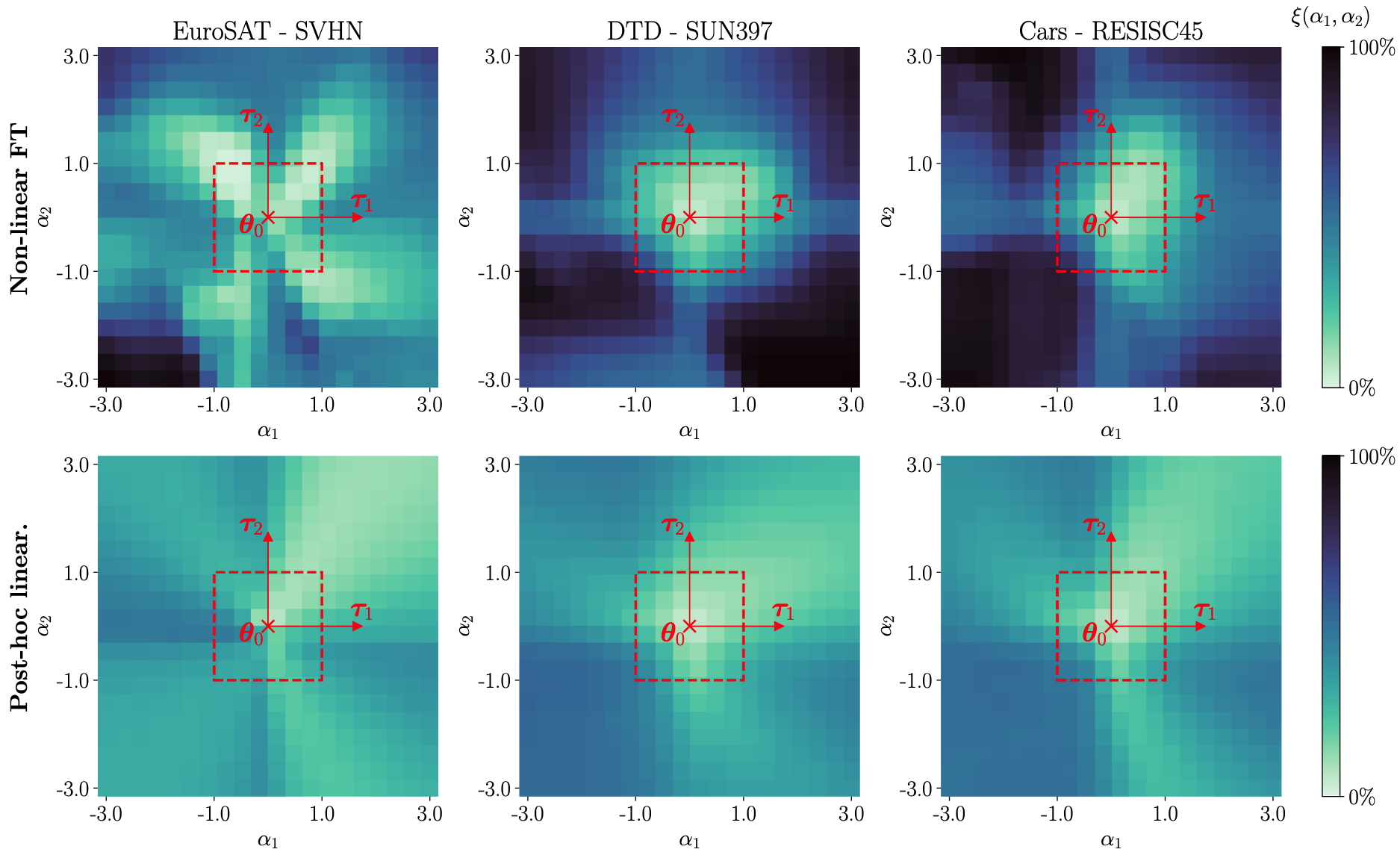
- 비선형 모델은
주변의 작은 영역에서만 낮은 Disentanglement Error 보임 - 선형화된 모델은 더 넓은 영역에서 낮은 Disentanglement Error 보임
- 이 때문에 여러 Task Vector를 한 번에 더했을 때의 성능은 선형화된 모델델 더 좋았음
- NTK 선형화가 Weight Disentanglement를 강화한다는 핵심 통찰
- 비선형 모델은
이론적 설명
- NTK Eigenfunction 국소화와 Task Arithmetic의 연관성
- NTK는 여러 고유함수와 고유값으로 분해 가능:
- 국소화된 고유함수: 특정 태스크 영역에서만 값을 가지고 다른 영역에서는 거의 0
- 고유함수가 모든 도메인에서 선형 독립일 경우, 서로 상쇄될 수 없음 → 국소화가 없으면 한 태스크의 고유함수가 다른 태스크 영역에 영향을 미쳐 Task Arithmetic이 불가능 → 즉 이 경우만 아니면 꼭 국소화가 필요한 것은 아님
- NTK는 여러 고유함수와 고유값으로 분해 가능:
- 사전 학습이 의미적으로 관련된 특성들을 구조화하는 과정에서 Eigenfunction 국소화가 발생
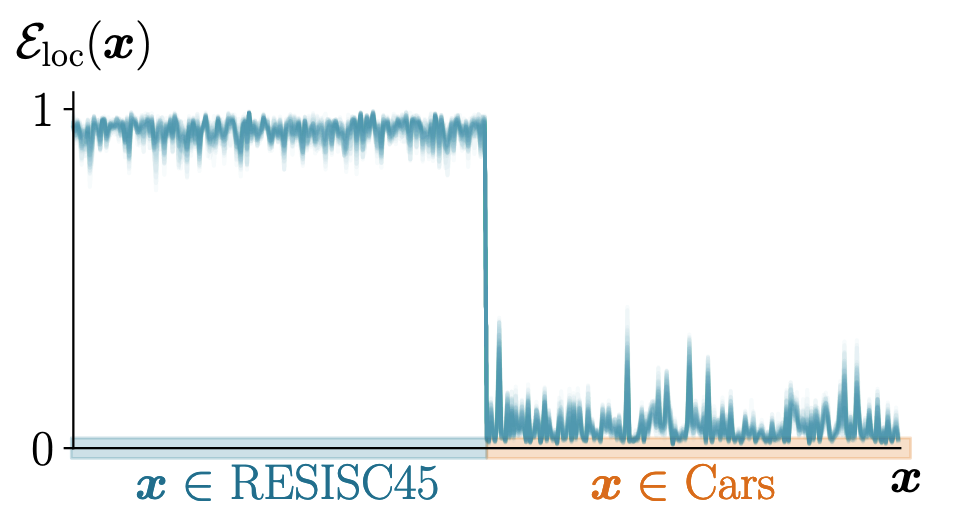
에 대해 커널의 Eigenfunctions들의 제곱합을 보면 다른 태스크의 영역에서는 값이 낮음
- Weight Disentanglement는 사전 학습의 창발적 특성임을 발견
Method
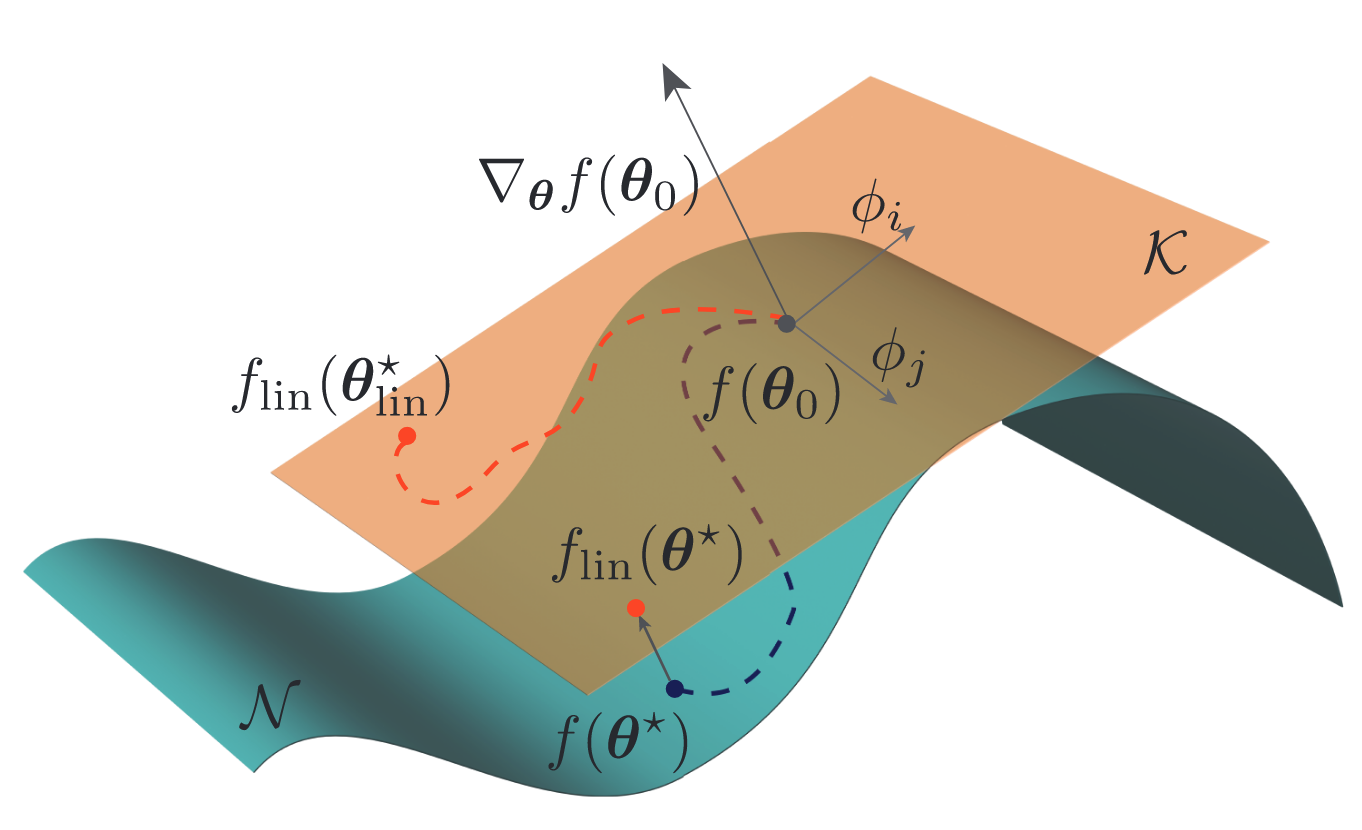
: Non-Linear FT, : Post-Hoc, : Linearized FT
- 비선형 파인튜닝(Non-Linear FT):
- 사전 학습된 모델 파라미터
에서 시작하여 직접 파인튜닝 - 결과 모델:
, 여기서 - 모델 편집:
- 비선형 레짐에서 작동하여 Weight Disentanglement가 제한적
- 사전 학습된 모델 파라미터
- 사후 선형화(Post-Hoc Linearization):
- 비선형 파인튜닝된 모델을 선형 근사
- 결과 모델:
- 모델 편집:
- 단일 태스크 성능은 저하되지만 Weight Disentanglement는 향상
- 선형화된 파인튜닝(Linearized FT):
- 원본 모델 파라미터
를 고정하고 선형화된 모델을 직접 파인튜닝 - 결과 모델:
- 모델 편집:
- 원본 모델 파라미터 동결(freeze)하고 차이값
만 학습 - 실제 구현 방법
- 원본 모델 파라미터
고정(freeze) - 새로운 파라미터
을 도입하여 이를 학습 - 각 순전파 과정에서 초기 출력
에 그래디언트-벡터 곱 을 더하여 계산 - Jacobian-vector product 구현을 통해 계산 효율성 확보
- 원본 모델 파라미터
- 원본 모델 파라미터
Method 검증
- Non-linear advantage가 Linearized FT를 적용하면 줄어 듦을 발견
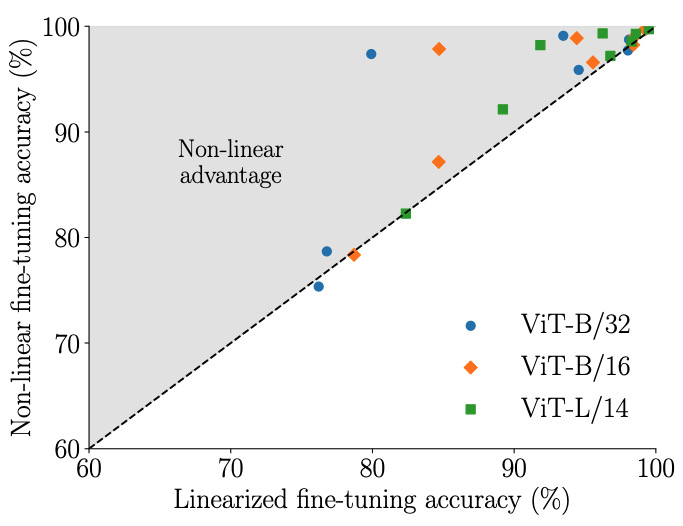
을 이용한 경우 NTK의 근사가 제대로 동작 (근사와 실제 값이 비슷함) → 선형 레짐에서 동작
- 태스크 추가(Task Addition) 실험 결과
- 선형화 파인튜닝이 비선형 파인튜닝 대비 단일 태스크와 모든 태스크 벡터를 더했을 때의 평균 성능에 대해 우수함
- 이는 Motivation에서 논의한 Weight Disentanglement 강화로 인한 것으로, Tangent Space에서 파인튜닝이 Task Arithmetic에 효과적임을 입증
- 정규화된 정확도에서도 선형화 파인튜닝 모델이 더 높은 성능 달성(85.4%, 86.0%, 93.5%)
- 태스크 부정(Task Negation) 실험 결과
- 선형화 파인튜닝이 제어 태스크 성능을 유지하면서 타겟 태스크 정확도를 더 효과적으로 감소
- 이는 Motivation에서 예측한 대로 선형화된 모델이 더 나은 Weight Disentanglement를 달성하여 태스크 간 독립성이 향상됨을 보여줌
- 사전 학습의 중요성 증명
- 무작위 초기화된 ViT에서는 Task Arithmetic이 작동하지 않음
- 이는 Motivation에서 설명한 국소화된 Eigenfunction이 사전 학습을 통해 형성된다는 이론과 일치
- Weight Disentanglement가 사전 학습의 창발적 특성임을 증명